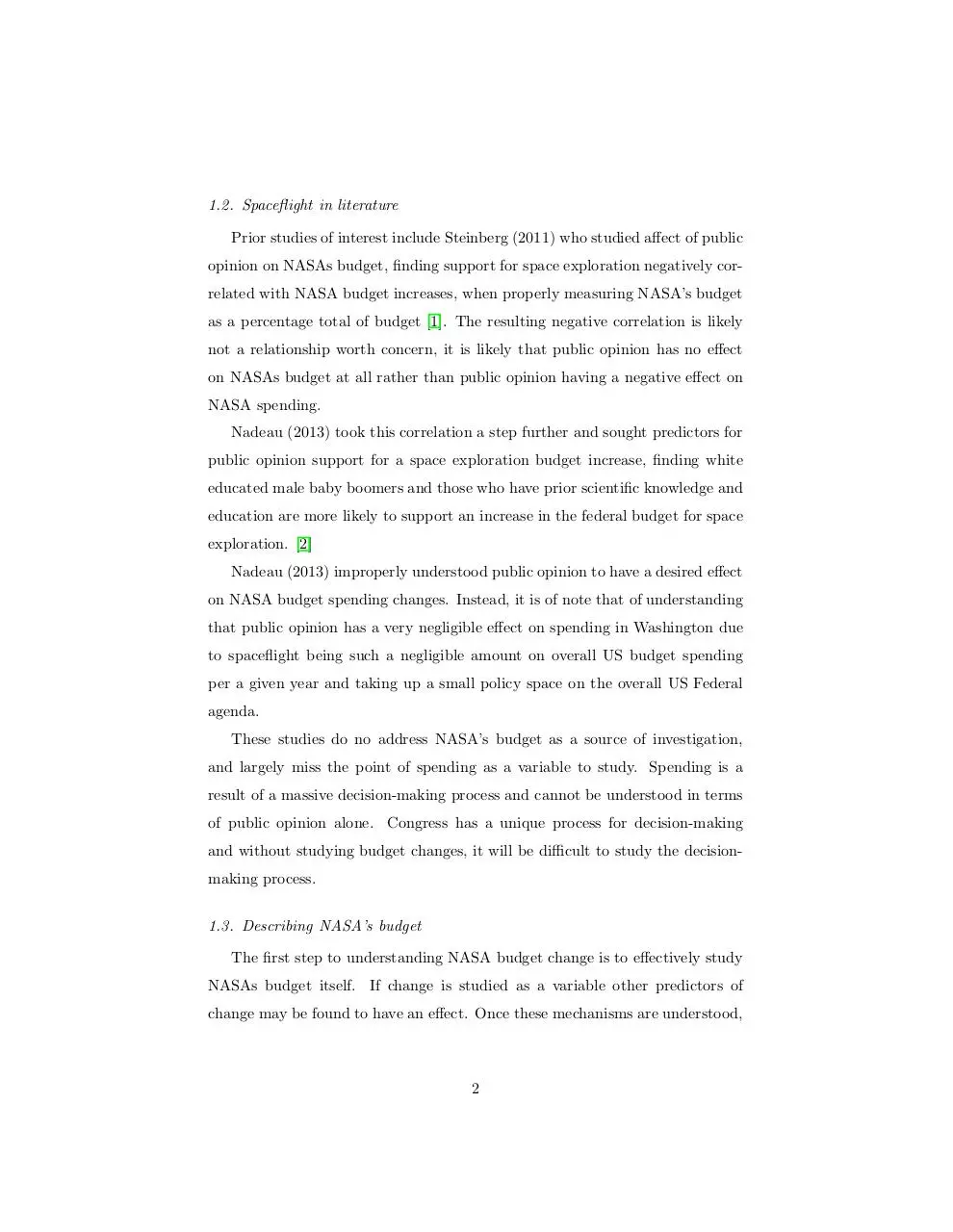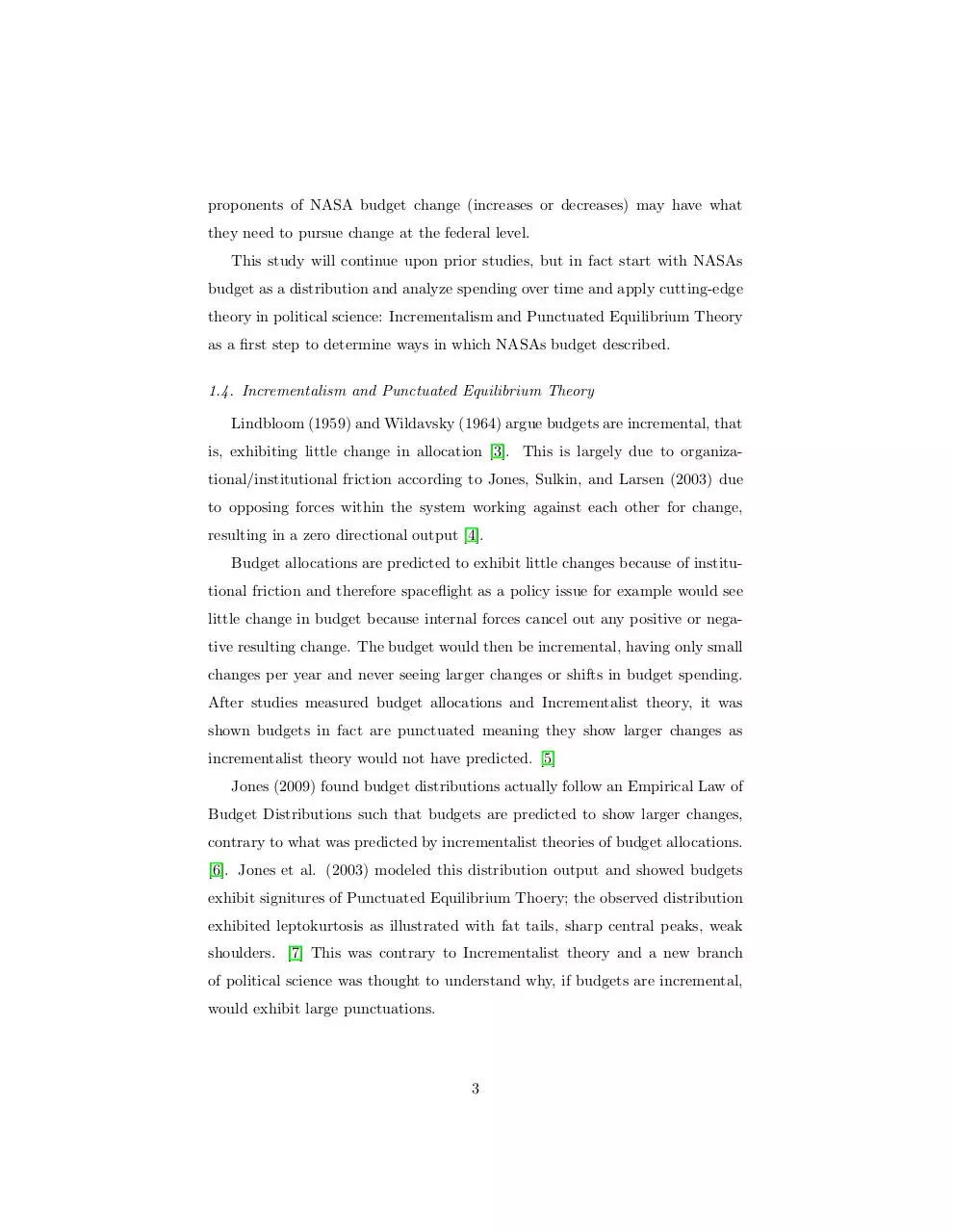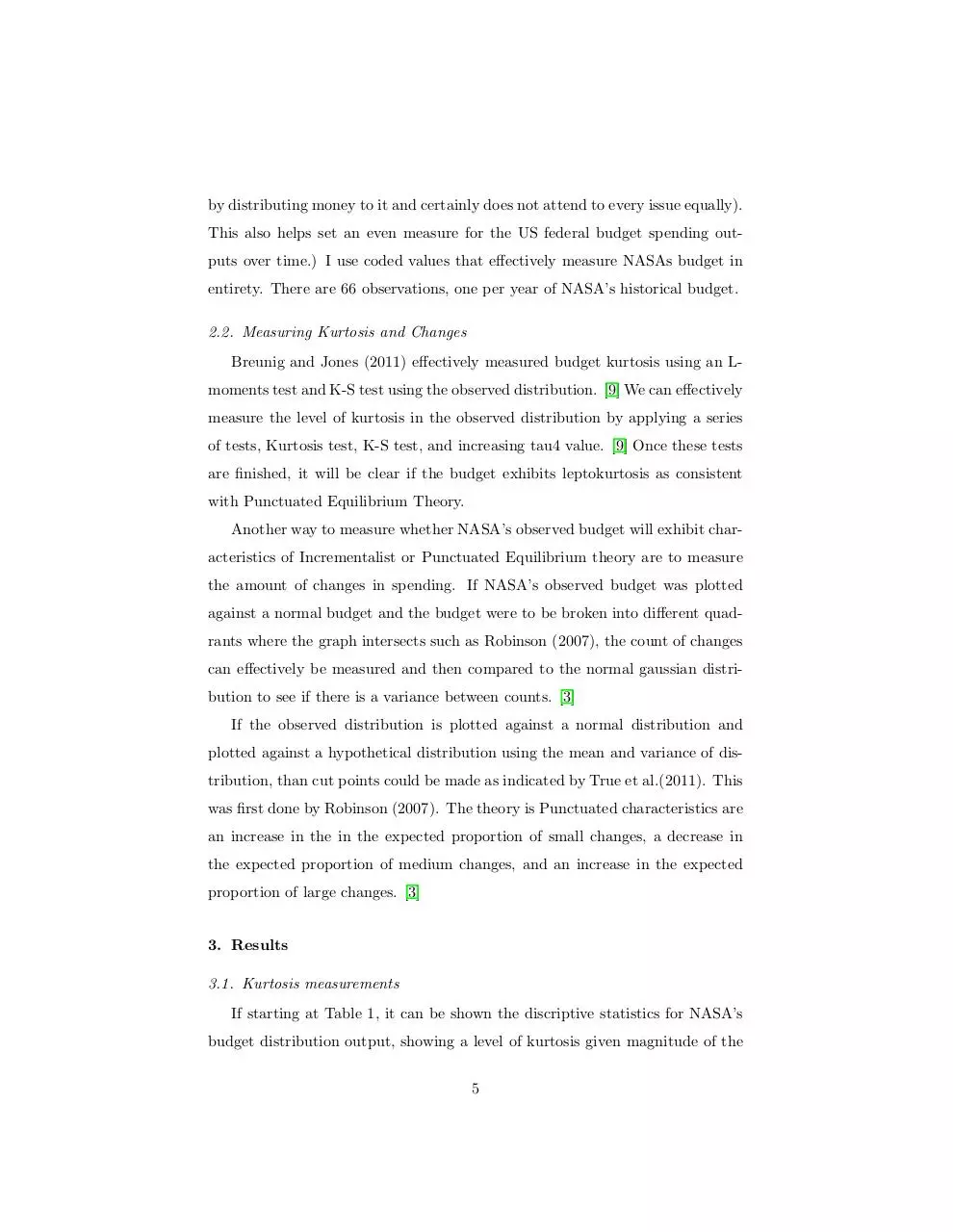nasa budget distribution (14) (PDF)
File information
This PDF 1.5 document has been generated by LaTeX with hyperref package / pdfTeX-1.40.17, and has been sent on pdf-archive.com on 21/09/2017 at 07:42, from IP address 76.73.x.x.
The current document download page has been viewed 405 times.
File size: 135.66 KB (11 pages).
Privacy: public file





File preview
NASA Budget Distribution: Incrementalism or
Punctuated Equilibrium Theory
Abstract
This article will attempt to study NASA’s budget as a distribution to investigate
changes in NASA’s budget from the years 1957-2014 using cutting-edge theories
in political science such as measuring for leptokurtosis and applying a predictive
distribution. Understanding NASA’s budget changes are the crucial first step
in understanding how NASA’s budget may change and proponents of NASA
might find whether NASA’s budget has been incremental or show punctuations
very useful. This paper will use kurtosis mathematical methods and Robinson
(2007) calculations for budget changes.
Keywords: National Aeronautics and Space Administration, budget
distribution, incrementalism, Punctuated Equilibrium Theory
1. Introduction
1.1. Studying NASA’s budget
NASA’s budget has not been fully understood becauase NASA’s budget has
not been a source of scrutiny in the academic literature. The history of studying
budgets may be found in political science works such as Jones et al. [? ] yet no
one has indeed applied these frameworks to NASA’s budget.
Understanding NASA’s budget will be crucial first step in understanding
NASA’s Congressional decision-making process. First, NASA’s empirical budget may be the output to which researchers can calculate back, apply theory,
and map the decision-making process. This information will be crucial for proponents looking to get NASA’s budget changed for example.
Preprint submitted to Space Policy Journal
September 21, 2017
1.2. Spaceflight in literature
Prior studies of interest include Steinberg (2011) who studied affect of public
opinion on NASAs budget, finding support for space exploration negatively correlated with NASA budget increases, when properly measuring NASA’s budget
as a percentage total of budget [1]. The resulting negative correlation is likely
not a relationship worth concern, it is likely that public opinion has no effect
on NASAs budget at all rather than public opinion having a negative effect on
NASA spending.
Nadeau (2013) took this correlation a step further and sought predictors for
public opinion support for a space exploration budget increase, finding white
educated male baby boomers and those who have prior scientific knowledge and
education are more likely to support an increase in the federal budget for space
exploration. [2]
Nadeau (2013) improperly understood public opinion to have a desired effect
on NASA budget spending changes. Instead, it is of note that of understanding
that public opinion has a very negligible effect on spending in Washington due
to spaceflight being such a negligible amount on overall US budget spending
per a given year and taking up a small policy space on the overall US Federal
agenda.
These studies do no address NASA’s budget as a source of investigation,
and largely miss the point of spending as a variable to study. Spending is a
result of a massive decision-making process and cannot be understood in terms
of public opinion alone. Congress has a unique process for decision-making
and without studying budget changes, it will be difficult to study the decisionmaking process.
1.3. Describing NASA’s budget
The first step to understanding NASA budget change is to effectively study
NASAs budget itself. If change is studied as a variable other predictors of
change may be found to have an effect. Once these mechanisms are understood,
2
proponents of NASA budget change (increases or decreases) may have what
they need to pursue change at the federal level.
This study will continue upon prior studies, but in fact start with NASAs
budget as a distribution and analyze spending over time and apply cutting-edge
theory in political science: Incrementalism and Punctuated Equilibrium Theory
as a first step to determine ways in which NASAs budget described.
1.4. Incrementalism and Punctuated Equilibrium Theory
Lindbloom (1959) and Wildavsky (1964) argue budgets are incremental, that
is, exhibiting little change in allocation [3]. This is largely due to organizational/institutional friction according to Jones, Sulkin, and Larsen (2003) due
to opposing forces within the system working against each other for change,
resulting in a zero directional output [4].
Budget allocations are predicted to exhibit little changes because of institutional friction and therefore spaceflight as a policy issue for example would see
little change in budget because internal forces cancel out any positive or negative resulting change. The budget would then be incremental, having only small
changes per year and never seeing larger changes or shifts in budget spending.
After studies measured budget allocations and Incrementalist theory, it was
shown budgets in fact are punctuated meaning they show larger changes as
incrementalist theory would not have predicted. [5]
Jones (2009) found budget distributions actually follow an Empirical Law of
Budget Distributions such that budgets are predicted to show larger changes,
contrary to what was predicted by incrementalist theories of budget allocations.
[6]. Jones et al. (2003) modeled this distribution output and showed budgets
exhibit signitures of Punctuated Equilibrium Thoery; the observed distribution
exhibited leptokurtosis as illustrated with fat tails, sharp central peaks, weak
shoulders. [7] This was contrary to Incrementalist theory and a new branch
of political science was thought to understand why, if budgets are incremental,
would exhibit large punctuations.
3
Punctuated Equilibrium results in punctuations in budget, and this is theorized to be because of the lack of policy reprioritizations that arise when government rethinks a policy issue and changes allocation of funding between issues.
This would be shown with a decrease or increase in budget per year given policy
issue type. A punctuated budget would predict both stability of incrementalism
but with rare dramatic changes. The greatest differences between Incrementalist
and Punctuated Equilibrium Theory are that in incrementalist theory changes
are small and punctuated equilibrium theory means larger changes are to be
expected.
This article will attempt to plot NASA’s budget distribution along with a
hypothetical distribution and apply Incrementalism and Punctuated Equilibrium theories to the budget distribution to analyze what type of distribution
NASA budget allocation has fallen under. Secondly, this article will analyze
changes in NASA’s budget and investigate where the changes have occurred
and when. Lastly, this paper will discuss implications these findings may have
on spaceflight.
2. Finding NASA’s Budget Distribution
2.1. Measurements
We start with 66 observations (one per year of change), NASAs budget
as a percentage change per year over the course of NASAs history, 1958-2014
as recorded by Policy Agendas Project, now Comparative Agendas Project. I
use Policy Agendas Project (updated April 2016) because variables are coded
as NASA’s budget rather than Comparative Agendas Project which codes the
data under separate policy issues effectively not given NASA’s budget in relation
to the total US federal budget. The coding is still consistent over time and
effectively isolates NASA’s budget numerically. [8]
I measure percentage change not in Dollars, but as percent total value. I do
this because of the zero-sum of attention per year (limited government funding,
caps that force unequal allocation as government cannot attend to every issue
4
by distributing money to it and certainly does not attend to every issue equally).
This also helps set an even measure for the US federal budget spending outputs over time.) I use coded values that effectively measure NASAs budget in
entirety. There are 66 observations, one per year of NASA’s historical budget.
2.2. Measuring Kurtosis and Changes
Breunig and Jones (2011) effectively measured budget kurtosis using an Lmoments test and K-S test using the observed distribution. [9] We can effectively
measure the level of kurtosis in the observed distribution by applying a series
of tests, Kurtosis test, K-S test, and increasing tau4 value. [9] Once these tests
are finished, it will be clear if the budget exhibits leptokurtosis as consistent
with Punctuated Equilibrium Theory.
Another way to measure whether NASA’s observed budget will exhibit characteristics of Incrementalist or Punctuated Equilibrium theory are to measure
the amount of changes in spending. If NASA’s observed budget was plotted
against a normal budget and the budget were to be broken into different quadrants where the graph intersects such as Robinson (2007), the count of changes
can effectively be measured and then compared to the normal gaussian distribution to see if there is a variance between counts. [3]
If the observed distribution is plotted against a normal distribution and
plotted against a hypothetical distribution using the mean and variance of distribution, than cut points could be made as indicated by True et al.(2011). This
was first done by Robinson (2007). The theory is Punctuated characteristics are
an increase in the in the expected proportion of small changes, a decrease in
the expected proportion of medium changes, and an increase in the expected
proportion of large changes. [3]
3. Results
3.1. Kurtosis measurements
If starting at Table 1, it can be shown the discriptive statistics for NASA’s
budget distribution output, showing a level of kurtosis given magnitude of the
5
kurtosis, K-S Test, and lastly increasing tau value. The resultant table is conclusive with Punctuated Equilibrium theory such that the values show kurtosis
in the distribution. Given test results it is clear the observed distribution of
NASA budget changes exhibits characteristics of leptokurthic budget distribution signaling towards Punctuated Equilibrium theory of budget changes.
3.2. Changes
As shown from Table 2, if the number of counts represented by small,
medium, and large positive and negative changes of the observed and expected
values are compared, it can be shown that there were a high amount of small
changes of observed values in comparison to the amount of small changes in a
normal distribution signifying leptokurtosis and Incrementalism.
The second part of the analysis deals with investigating medium changes,
and the observe distribution shows less medium changes that expected signifying
punctuated characteristics. Given there are only 66 observations and not 1000,
looking at large changes is negligible given it takes a significant number of
observations for rare occurrences to occur. [3]
4. Conclusion
In conclusion, it is clear the observed distribution showed signatures of Punctuated Equilibrium theory, as indicated by the results of the first analysis as
shown the descriptive statistics of Table 1. The observed distribution passes
the litmus test of whether the distribution shows characteristics of leptokurtosis as predicted by Punctuated Equilibrium theory or a normal distribution as
predicted by Incrementalism.
Given table 2, is it clear the budget when applied to the hypothetical distribution shows signs of Punctuated equilibrium theory as shown by the observed
proportion of small changes greatly out predicts the hypothetical distribution
and the predicted amount of medium changes is less than the amount of observed
changes.
6
Further, it is of note the vast information this data presents and how predictors of budget change may find it as the crucial first step to understanding
changes. NASA’s budget distribution exhibits characteristics of Punctuated
Equilibrium, not Incrementalism. It is incorrect to describe NASA’s budget
as Incremental despite the large numbers of small changes. This is simply not
enough of a description. NASA’s budget also shows less medium changes than
expected with Incrementalism and predicted by the normal distribution. This
can still be because of internal forces cancelling out other forces resulting in
small changes in the distribution and lack of medium ones.
What this information presents is that NASA’s budget is due for a large
change eventually as predicted by the Law of Empirical budgets. NASA’s budget, given 1,000 observations, is likely to erupt in a large change and will not
remain in stasis incrementalism forever. The data already with 66 observations
show the budget is punctuated not incremental and therefore change is expected.
Proponents of this information might find it useful to understand the Congressional decision making process and study internal forces within the institution to isolate causal reasons for budget change. If factors of change are
understood, then proponents of NASA budget change may effectively cause the
crisis to get the budget changed largely over the course of a given year. Proponents take note NASA budget may seem incremental however predicts larger
changes in the future.
References
[1] A. Steinberg, Space policy responsiveness: The relationship between public
opinion and nasa funding, Space Policy 27:4 (2011) 240–246.
[2] F. Nadeau, Explaining public support for space exploration funding in america: A multivariate analysis, Acta Astronautica 86 (2013) 158–166.
[3] S. E. Robinson, Explaining policy punctuations: Bureaucratization and budget change, Midwest Political Science Association 51:1 (2007) 140–150.
7
Table 1: Distribution Statistics for Distribution Analysis
Distribution Stats
mean
0.05852036
sigma
0.3088144
range
-0.6818182:1.3846154
skew
0.07988493
Kurtosis
5.050872
K-S test
4.293e-08
tau4
0.4136329
Table 2: Results of Observed versus Gaussian distribution changes
Expected Versus Observed Budget Changes
Expected Exp Percentage Observed Obser Percentage
Large Negative
1.00
0.0151
1.00
0.0151
Medium Negative
8.00
0.121
8.00
0.121121
Small
15.0
0.227
42.00
0.636
Medium Positive
18.0
0.273
9.00
0.136
Large Positive
24.0
0.364
6.00
0.091
8
2
0
1
Density
3
4
density.default(x = Budg)
−0.5
0.0
0.5
1.0
N = 66 Bandwidth = 0.04042
Figure 1: Epirical Distribution plotted against hypothetical Gaussian distribution
[4] S. T. Jones, Bryan D., H. A. Larsen, Policy punctuations in american political institutions, American Political Science Review 1:1 (2003) 151–169.
[5] J. B. D. True, J., F. Baumgartner, Punctuated-equilibrium theory: Explaining stability and change in american policymaking, Theories of the policy
process (2011) 97–115.
[6] B. D. Jones, et al., A general empirical law of public budgets: A comparative
analysis, American Journal of Political Science 405 (2009) 885–873.
[7] S. T. Jones, Bryan D., H. A. Larsen, Policy punctuations in american political institutions, American Political Science Review 1.
[8] F. Baumgartner, B. D. Jones, The Policy Agendas Project, University of
Texas at Austin, 2013.
9
1.5
NASA Spending Distribution Plotted with Norm
5
4
Density
4
3
3
2
2
1
1
0
0
−0.5
0.0
0.5
1.0
1.5
Year of Spending
Figure 2: Distribution plotted against Gaussian with cutpoints sectioned
[9] C. Breunig, B. D. Jones, Stochastic process methods with an application to
budgetary data, Political Analysis 19 (2011) 103–117.
10
0.5
0.0
−0.5
Sample Quantiles
1.0
Normal Q−Q Plot
−2
−1
0
1
Theoretical Quantiles
Figure 3: Leptokurtosis Q-Q Plot test
11
2
Download nasa-budget-distribution (14)
nasa-budget-distribution (14).pdf (PDF, 135.66 KB)
Download PDF
Share this file on social networks
Link to this page
Permanent link
Use the permanent link to the download page to share your document on Facebook, Twitter, LinkedIn, or directly with a contact by e-Mail, Messenger, Whatsapp, Line..
Short link
Use the short link to share your document on Twitter or by text message (SMS)
HTML Code
Copy the following HTML code to share your document on a Website or Blog
QR Code to this page

This file has been shared publicly by a user of PDF Archive.
Document ID: 0000676280.